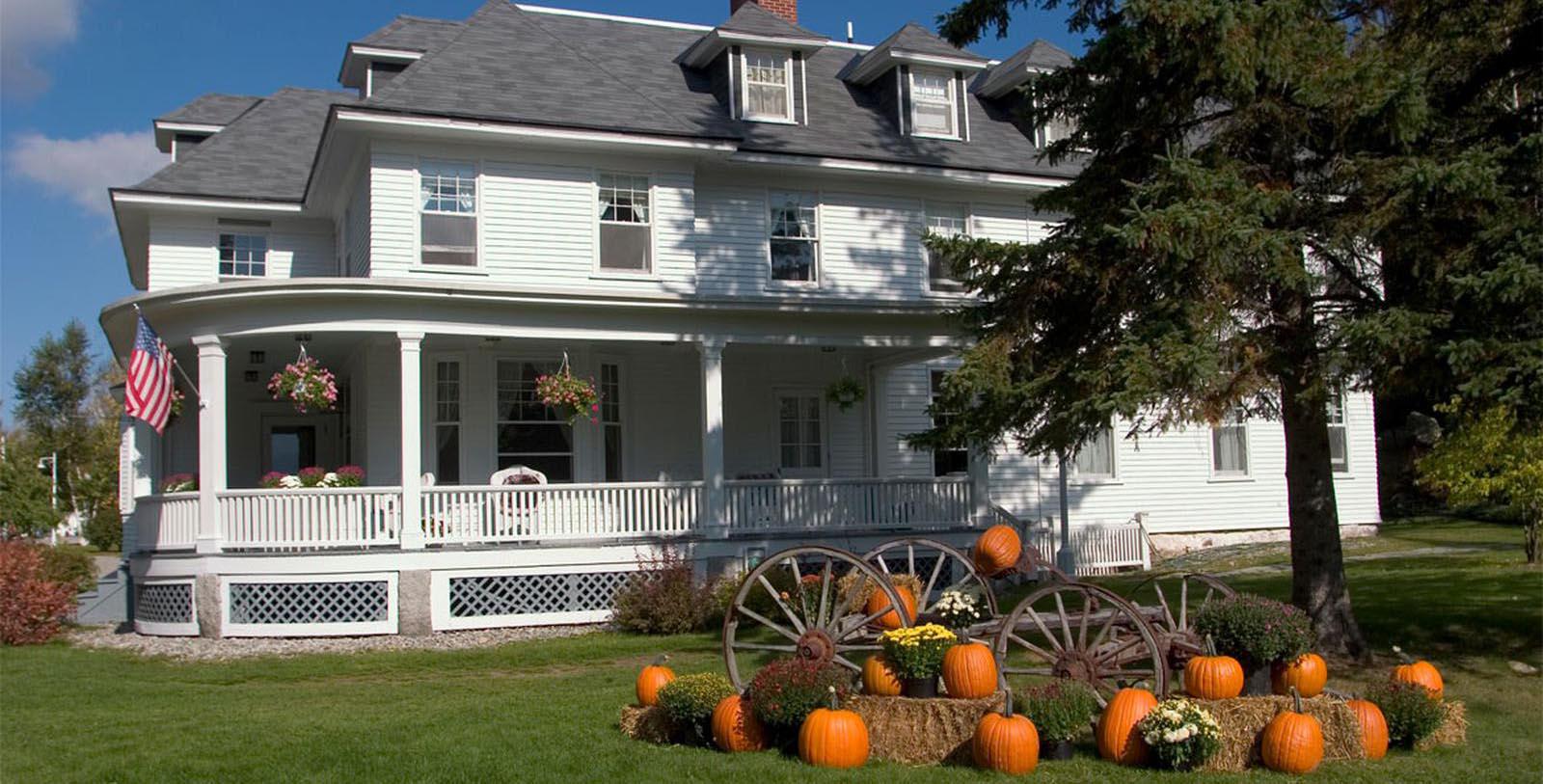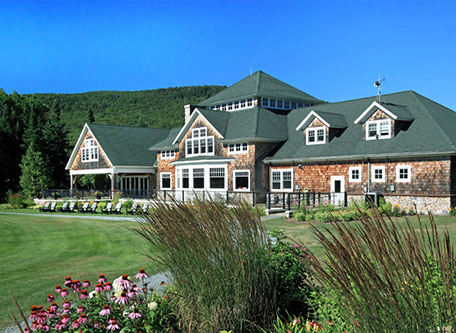Receive for Free - Discover & Explore eNewsletter monthly with advance notice of special offers, packages, and insider savings from 10% - 30% off Best Available Rates at selected hotels.
history
Discover the Omni Bretton Arms Inn, which was originally opened as a private residence in 1896 before joining The Mount Washington Resort.
Omni Bretton Arms Inn, Bretton Woods, a charter member of Historic Hotels of America since 1989, dates back to 1896.
VIEW TIMELINEOriginally built as a private residence in 1896, the Omni Bretton Arms Inn first opened its doors to guests in 1907. It debuted with the name “Bretton Army Country Inn” and largely functioned as a supplementary housing unit for guests at the nearby Mount Washington Hotel. In fact, The Bretton Army Country Inn functioned as part of the Mount Washington Hotel’s complex throughout much of its history. The Mount Washington Hotel—known today as the “Omni Mount Washington Resort”—actually debuted before the public for the first time some six years later. The man responsible for creating the entire enterprise, Joseph Stickney, had passed away right after the Mount Washington Hotel opened. Upon his death, his beloved wife, Carlyon Foster Stickney, inherited the entire business. Thus, it was Carolyn who decided to purchase The Bretton Arms Country Inn and convert it into an exclusive component of the Mount Washington Hotel. Together, the Mount Washington Hotel and The Bretton Arms Country Inn would become one of New Hampshire’s most exclusive resort complexes. The Bretton Arms Country Inn even played an integral role when the Mount Washington Hotel hosted the Bretton Woods Conference in 1944, serving as the headquarters for the conference secretariat throughout the event.
In 1955, the Fleischer family of Philadelphia acquired the entire facility, who managed the location for the next 15 years. They then sold it to a local real estate business called the Mount Washington Development Company. It was around this time that The Bretton Arms Country Inn was converted into a dormitory for the Mount Washington Hotel’s staff. Yet, the Mount Washington Development Company’s tenure as the steward for this amazing destination proved to be short-lived, as it, too, transferred control over to the Bretton Woods Corporation in 1975. The Bretton Woods Corporation invested millions into thoroughly renovating the resort back to its former glory, resulting in its inclusion in the National Register of Historic Places. The construction work was so successful that the Secretary of the Interior even recognized both the Mount Washington Hotel and the Bretton Arms Country Inn as a single National Historical Landmark in 1985. In a spell of further good news, the Bretton Woods Corporation significantly renovated The Bretton Arms Country Inn and reopened it as a wonderful boutique hotel in 1986. Subsequent renovations to The Bretton Arms Country Inn occurred in 2012, when some $1.4 million was spent to completely refurbish the whole building. Omni Hotels and Resorts now manages this stunning historic destination as the “Omni Bretton Arms Inn.”
-
About the Location +
The Omni Mount Washington Resort derives its name from Mount Washington, a celebrated national landmark that defines the landscape of White Mountain National Forest. The location possesses the highest point in the entire northeastern United States, with an elevation of more than 6,000 feet. Originally called “Agiocochock” by local Native American tribes, Mount Washington was named after George Washington shortly after the conclusion of the American Revolutionary War. The use of his name began a tradition in which the names of other U.S. presidents would be applied to the neighboring mountains. In all, eight other mountains bore the names of various presidents, forming a geographic location known as the “Presidential Range.” Those individuals are as follows:
- John Adams, 2nd President of the United States
- Thomas Jefferson, 3rd President of the United States
- James Monroe, 4th President of the United States
- James Madison, 5th President of the United States
- John Quincy Adams, 6th President of the United States
- Franklin Pierce, 14th President of the United States and New Hampshire’s only native son to sit in the Oval Office
- Dwight D. Eisenhower, 35th President of the United States
But local officials continued to name neighboring mountains after other prominent national figures, including Senators Henry Clay and Daniel Webster, as well as Founding Father Benjamin Franklin. The Presidential Range is one of the central features within White Mountain National Forest and can be navigated by traveling along the Presidential Traverse.
Mount Washington itself has attracted curious travelers for years due to its dominant command over the entire area. In fact, John Sebastian Cabot—one of the first Europeans to explore the New England coastline—could even see the mountain’s peak from the Gulf of Maine miles away. Americans have continuously visited Mount Washington ever since, as many have hiked through the region to experience its fauna and wildlife. Mount Washington today serves as a training ground for experienced hikers who plan to climb such harrowing destinations as Mount Everest and K2. In order for nature enthusiasts to traverse the steep topography of Mount Washington and the greater the Presidential Range, local outdoorsmen cut several massive trails throughout the countryside. Among the most historic of those trails is the Crawford Path, which was first developed by Ethan Allan Crawford in 1819. The pathway navigates the Crawford Notch to reach the summit of Mount Washington. Yet, there are many other novel ways to access the mountain, including the Victorian-era Mount Washington Cog Railway. Founded in 1868, it is the world’s first mountain-climbing cog railway!
-
About the Architecture +
Unlike the other historical buildings at the Omni Mount Washington Resort, the Omni Bretton Arms Inn displays a magnificent blend of Queen Anne-style architecture. A successor to Eastlake architecture, Queen Anne became a widely popular architectural style at the height of the Gilded Age. Named in honor of 18th-century British monarch, Queen Anne, the architectural form started in England before migrating to the United States. But its name is misleading, as it actually borrowed its design principles from buildings constructed during the Renaissance. While the appearance of Queen Anne-style buildings may differ considerably, they are all united by several common features. For instance, they are typically asymmetrical in nature, and are built with some combination of stone, brick, and wood. Those buildings also feature a large wrap-around porch, as well as a couple polygonal towers. Those towers may also be accompanied by turrets along the corners of a building’s exterior façade. Queen Anne structures also have pitched, gabled roofs made with irregular shapes and patterns. Intricate wood carvings are a common sight throughout their layout, too, and are often designed in such a way to resemble different objects like an illusion. Clapboard paneling and half-timbering are a few other forms of woodworking that are regularly found somewhere within a Queen Anne-style structure.
-
Famous Historic Events +
Bretton Woods Conference (1944): The Omni Mount Washington Resort played an integral role in establishing the International Monetary Fund (IMF) and the World Bank. Both organizations came into being at the height of World War II, when 44 different countries met at the Omni Mount Washington Resort to discuss the restoration of the global economy. The gathering would go down in history as the “Bretton Woods Conference.” It was attended by some of the most noteworthy politicians of the day, including John Maynard Keyes of the United Kingdom and Henry Morgenthau Jr. of the United States. All of the representatives agreed to a project known as the International Bank for Reconstruction and Development (IBRD), whose purpose was to provide financial aid for countries heavily affected by the war. The IBRD would later give birth to the World Bank. They also consented to create an International Monetary Fund, which would regulate imbalances in international payments while also stabilizing exchange rates. The two financial organizations still exist today and have been an essential component to bolstering the global economy in times of crisis.
In preparation for the Bretton Woods Conference, the federal government sent 150 workers to the hotel in order to renovate its accommodations. Each worker received 50 cans of white paint and were told that, “if it didn’t move, it should be painted white.” As such, the mahogany doors—as well as several brass light fixtures and Tiffany windows—were completely painted white. The U.S. State Department also sent hundreds of pieces of new furniture to the hotel to give it a timeless appeal. Activity throughout the Mount Washington Hotel resembled that of a bustling beehive. In all, the federal government invested millions of dollars into the project and requested that the construction work only take two months to finish. Nevertheless, the renovations impressed the many representatives who went to the hotel that July. The continued to use the resort long after their debates had ended, as the dignitaries from the leading nations in attendance signed the official articles establishing the IBRD and the IMF within the resort’s now-famous Gold Room. (The Gold Room had originally been Carolyn Foster Stickney’s private dining room).

































